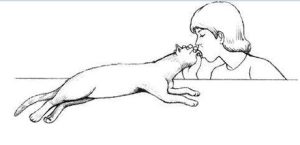ARTIFICIAL RESPIRATION
Any occasion in which you have to resort to artificial respiration is an emergency (except perhaps in a newborn kitten that is slow to start breathing). Don’t spend all your time trying to revive the cat on the spot. As soon as your veterinarian is contacted, head for the clinic while continuing attempts at resuscitation.
ARTIFICIAL RESPIRATION
SIGNS OF DEATH
Artificial respiration serves no purpose in an already dead animal.
Place your ear on the unconscious cat’s chest and listen for a heartbeat; feel for a pulse. If no pulse or heartbeat is detectable and the pupils are dilated and nonresponsive to light, it is probable that death has already occurred and that your first aid will be useless. However, you can try external heart massage.
To administer artificial respiration, open the cat’s mouth, pull out the tongue, and look as far back into the pharynx as possible to see if there are any obstructions. If you can’t see anything, it is a good idea to feel for obstructions with your fingers and remove any you find. However, you must take extraordinary care when doing this as a bite from a semiconscious animal can be severe. Wipe away excessive mucous or blood in the pharynx that might interfere with the flow of air. Extend the cat’s head and neck. Then close the cat’s mouth. Inhale. Holding the cat’s mouth closed, place your mouth over his or her nose (cover it completely) and exhale, forcing the exhaled air through the cat’s nose into the chest. Since cats are small your mouth may cover the whole anterior (front) part of the muzzle.
Watch for the chest to expand as you blow. After inflating the lungs in this manner, remove your mouth to allow the chest to return to its original (deflated) position. Repeat the inflation-deflation cycle twelve to twenty-four times per minute as long as necessary. If the heart is beating and you have been quick to relieve an airway obstruction, respiration may resume within a few minutes. These procedures put the resuscitator at significant risk of accidental injury and should be undertaken only by those willing to assume such risk.
